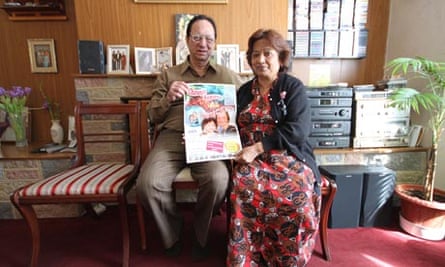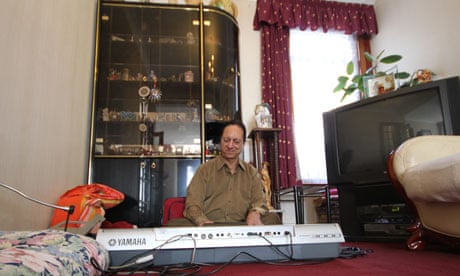Cast your mind to the acid house scene and your immediate thought probably doesn't involve an ageing Bollywood session musician. Yet the softly spoken Indian man who greets me at the door of his friend's suburban Acton home on a sunny Sunday morning is credited with creating what some have labelled the first ever acid house record.
Charanjit Singh's back catalogue could have disappeared into musical obscurity were it not for the cult album Ten Ragas to a Disco Beat that he created in a few days in Mumbai in 1982. The album is one of the earliest records to use the legendary Roland TB 303 synth – a machine synonymous with the acid house sound – and Singh paired this with the equally renowned Roland TR 808 to create an album astonishingly unusual and ahead of its time. So far ahead, in fact, that it appears to pre-date the first acid house records to come out of Chicago by about five years.
While the record seems extraordinary, to its creator its origins were rather straightforward. "There was lots of disco music in films back in 1982," says Singh matter of factly. "So I thought why not do something different using disco music only. I got an idea to play all the Indian ragas and give the beat a disco beat – and turn off the tabla. And I did it. And it turned out good."
As we drink tea and eat biscuits with his wife in the strikingly ordinary west London home in which he is staying briefly, I am struck by Singh's naturally shy demeanour and his absolute bemusement about the growing interest in Ten Ragas. One reason for Singh's air of surprise is the fact that the record was a commercial failure when it was first released. "It didn't click," says Singh with the resignation of the session musician whom fame has passed by. "It didn't have any publicity. Only sometimes you could hear it on the All Indian radio station, filling the gaps."
But if it failed to make an impact on its release, it's certainly clicking with a lot of people now. While Ten Ragas is not the only pre-acid house record to use the 303, it's perhaps the only one that sounds like it should have influenced acid house (impossible, given that the musicians credited with giving shape to the genre could never have heard the album at the time). This has been one of the key factors in driving the album's march to fame since its "re-discovery" and re-issue two years ago.
With this fame though has come a level of notoriety – and uncertainty. Much has been made of the album's astonishingly advanced sound palette, the high recording quality, and the unexpected use of a 303 on a record made in Mumbai so soon after the machine's official release in Japan at the end of 1981. These factors, coupled with the original record's astonishing rarity and extremely unlikely and enigmatic creator, have led many to believe the album was a hoax.

Until now, Singh has not helped the conspiracy theorists by remaining silent on the issue. Living in relative obscurity in Mumbai makes him a difficult man to track down. This rare trip to the UK affords me a unique opportunity to shed more light on this hugely important record.
But, as my interview with him progresses, it becomes increasingly obvious that Singh's shy demeanour makes him a difficult man to interview. No amount of questioning yields much more detail than what is already known about the album. I now understand why Edo Bouman, the man responsible for the official re-issue of Ten Ragas, warned me that Singh was "quite mellow and shy" and advised me to ask him "very simple step by step questions".
Despite this warning I am still frustrated that Singh seems unable to give more specific detail on when and where he recorded the album. He is also hazy on the details of exactly where he bought the 808 and 303 and cannot give any real reasons as to why he chose to buy them in the first place. "The 303 – that was something new," he explains. "It just came out. I went to Singapore and bought it from there."
With some more gentle probing he explains that he was intrigued by the way he could use the 808 and 303 in synch with the Roland Jupiter-8 keyboard. He explains that he didn't know much about the machines when he bought them and that he had to spend time learning how to use them properly. "At home I practised with the combination and I thought 'It sounds good – why not record it'".
Throughout our conversation it also becomes obvious that Singh is relatively unaware of the music that Ten Ragas is often compared to. So, I decide to play him a selection of famous acid tracks to see if he can find any similarities between the music that became known as acid and what he did with Ten Ragas.
Having explained that much of the music that Ten Ragas is compared to comes from Chicago, we settle down to listen to the record that arguably started it all – Acid Trax by Phuture. Singh listens intently but seems unmoved by the pulsing, stripped down music – and the signature squelch of the 303. "It's quite simple" he concludes after around three minutes, gently chuckling at the idea that there are similarities between Acid Trax and Ten Ragas. "It's very simple this music," he says. "What I played are ragas – there's a lot of variation."
Singh's wife Suparna seems more interested and asks for more detail about the nightclub context that Acid Trax would be most suited to. "Is this very popular?" she asks somewhat dubiously as the record continues to play. As we talk over the music I become increasingly aware of the oddness of the situation – listening to loud acid house at 12.30 on a Sunday afternoon in a suburban house in Acton with a couple of genial 60-year-olds visiting from Mumbai is indeed a strange scenario.
Undeterred I try out another track, this time opting for Flow Coma from 808 State's seminal acid house album Newbuild from 1988. As I explain that the track was recorded in Manchester, Singh appears more engaged and after a while concludes "this is more interesting". Again though, as the track progresses, Singh seems relatively unimpressed and slightly bewildered by the peculiar noises emanating from the hi-fi system.
In order to illustrate the differences in his approach, Singh treats me to a performance of one of his recent compositions. While his failure to provide more context to Ten Ragas is frustrating, Singh is utterly charming throughout our interview, and never more so than when he settles down at one end of the living room behind his new Yamaha keyboard. As he does so it becomes apparent that this is a man who is more at home simply playing music rather than answering questions about it.
This is my enduring memory of our meeting. I am left with the feeling that Singh is not entirely sure himself why he did what he did back in 1982. Further, he is equally unsure why such a fuss is being made of Ten Ragas now. The album was in many ways just another in a long line of recordings for Singh. But in others it is truly unique. Talking to Singh nearly 30 years on, there is a sense that he is only just starting to realise this.
This article previously referred to "Midi technology" on the 808 and 303 – an error which has now been corrected

Comments (…)
Sign in or create your Guardian account to join the discussion